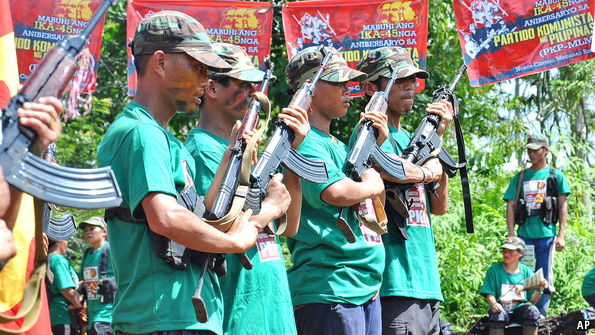A 30-year-old peace process resumes

A long way from the Netherlands
WHEN negotiators sat down together in Oslo this week in an effort to end the Philippines’ 47-year-old communist insurgency, they expressed the hope that a peace deal could be wrapped up within a year. That is optimistic: the two sides have been talking on-and-off for 30 years, without success. Their jerky progress towards the negotiating table in recent weeks is an ominous portent.
The Philippines’ new president, Rodrigo Duterte, had promised to resume talks during his election campaign, and declared a unilateral ceasefire within a month of his inauguration in late June. But the communists failed to reciprocate immediately.
Instead, communist guerrillas ambushed some government militiamen in the southern Philippines, killing one and wounding four. Mr Duterte promptly called off the truce, just before the communists declared their own ceasefire, which was subsequently rescinded. It was only after the government released some insurgents, and the communists reciprocated, that the two sides reinstated the ceasefires, allowing the talks to go ahead.
The man the government regards as the leader of the communists is Jose Maria Sison. Mr Sison founded the Communist Party of the Philippines (CPP) in 1968, and later an armed wing called the New People’s Army (NPA), with the aim of overthrowing Ferdinand Marcos, the president of the day. The insurgency blazed when Mr Marcos imposed martial law on his way to becoming a kleptocratic dictator. The NPA boasted of its thousands of armed guerrillas. The Philippines looked as if it might become the next South-East Asian domino to fall to communism—until Mr Sison was captured and imprisoned.
Mr Sison’s revolution has become a hopeless cause, thanks both to the restoration of democracy and infighting within the communists’ ranks. But the NPA remains a deadly nuisance, especially in rural areas on the southern island of Mindanao. It extorts money from businesses, typically setting fire to equipment belonging to construction companies or blowing up base stations belonging to mobile-phone networks that refuse to pay its revolutionary “taxes”. But its guerrillas failed to mount a single big operation last year, and their number had dwindled to fewer than 4,000 by the end of the year, according to the army. They tend to avoid combat, so outbreaks of fighting are rare and brief.
Previous efforts at making peace have been thwarted by the insurgents’ insistence on the release of detainees they regard as political prisoners but the government considers common criminals. Among the 20 prisoners the government freed to allow the latest talks to proceed were a married couple, 65-year-old Benito Tiamzon, the suspected chairman of the CPP, and 63-year-old Wilma Tiamzon, the suspected secretary-general. Both were released on bail despite facing multiple charges of murder, attempted murder and kidnapping. They immediately went to Oslo to join the communist negotiating team.
The communists will press for the release and pardon of more such figures. But the government will be sceptical that the ageing negotiators, long separated from their fighters by exile or prison bars, still have the authority to order a permanent end to nearly half a century of conflict.
http://www.economist.com/news/asia/21705824-30-year-old-peace-process-resumes-rebels-their-dotage

No comments:
Post a Comment
Note: Only a member of this blog may post a comment.